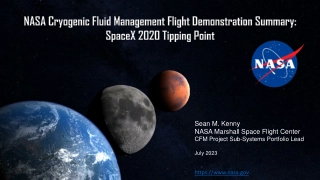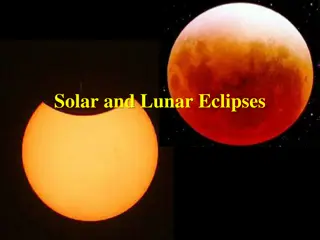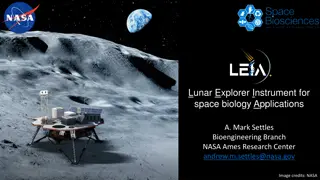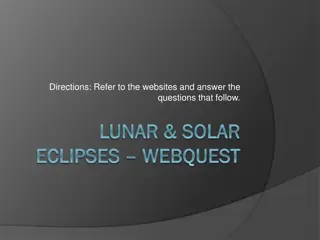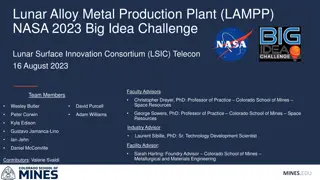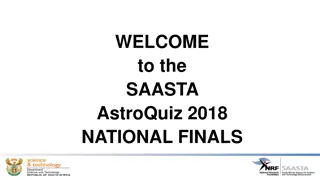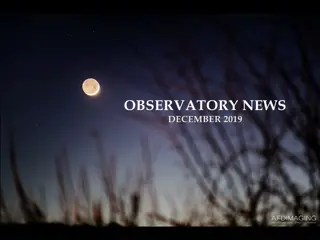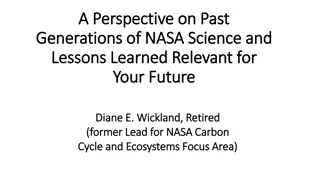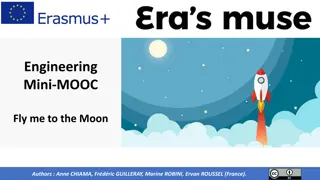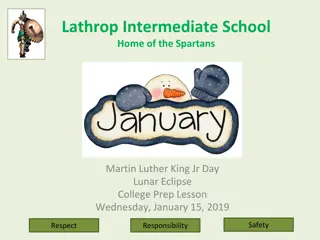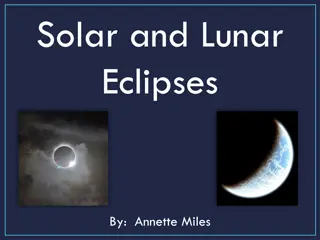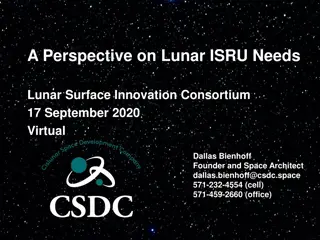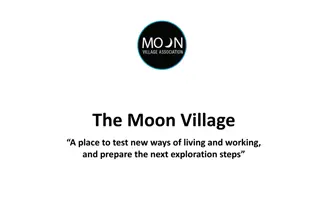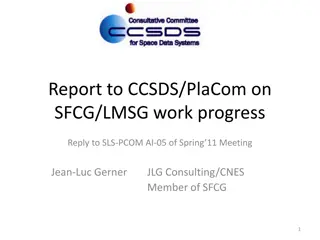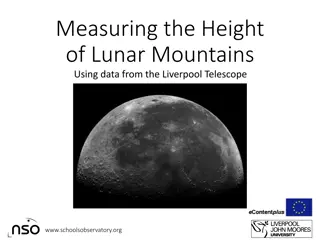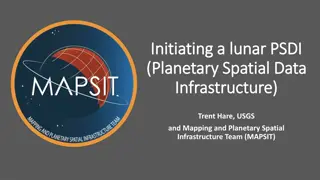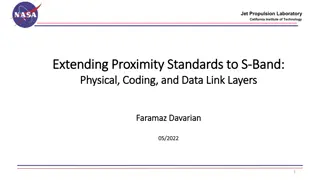NASA Integrated Lunar Science Strategy in the Artemis Era Implementation Plan
This implementation plan outlines strategic lunar programs, human exploration missions, and science objectives to achieve decadal-level goals at the Moon. It addresses the recommendations for lunar science priorities and aims to integrate human exploration with robotic missions for enhanced scientific outcomes.
Download Presentation

Please find below an Image/Link to download the presentation.
The content on the website is provided AS IS for your information and personal use only. It may not be sold, licensed, or shared on other websites without obtaining consent from the author.If you encounter any issues during the download, it is possible that the publisher has removed the file from their server.
You are allowed to download the files provided on this website for personal or commercial use, subject to the condition that they are used lawfully. All files are the property of their respective owners.
The content on the website is provided AS IS for your information and personal use only. It may not be sold, licensed, or shared on other websites without obtaining consent from the author.
E N D
Presentation Transcript
Implementation Plan for a NASA Integrated Lunar Science Strategy in the Artemis Era Sarah Noble PSD Lead for Lunar Science/ESSIO Program Scientist
Planetary Community Science Priorities 2007 2017 2020 2022 2016 2
From the Planetary Decadal Recommendations: PSD should develop a strategic lunar program that includes human exploration as an additional option to robotic missions to achieve decadal-level science goals at the Moon. Conducting decadal-level science should be a central requirement of the human exploration program. 3
Decadal Lunar Themes Moon to Mars Objectives LPS-1LM: Uncover the record of solar system origin and early history, by determining how and when planetary bodies formed and differentiated, characterizing the impact chronology of the inner solar system as recorded on the Moon and Mars, and characterize how impact rates in the inner solar system have changed over time as recorded on the Moon and Mars. Science Theme 1: Uncover the lunar record of solar system origin and early history. The Moon s composition, structure, and ancient surface preserve a record of early events: from the giant impact that produced the Earth Moon system to ongoing bombardment as life on Earth emerged and evolved. Science Theme 2: Understand the geologic processes that shaped the early Earth that are best preserved on the Moon. The Moon retains a record of processes that set the evolutionary paths of rocky worlds, including volcanism, magnetism, tectonism, and impacts. LPS-2LM: Advance understanding of the geologic processes that affect planetary bodies by determining the interior structures, characterizing the magmatic histories, characterizing ancient, modern, and evolution of atmospheres/exospheres, and investigating how active processes modify the surfaces of the Moon and Mars. Science Theme 3: Reveal inner solar system volatile origin and delivery processes. The Moon hosts water and other volatiles in its interior, across its surface, and in ice deposits at its poles, providing a record that may help constrain the origins of Earth s oceans and the building blocks for life, as well as ongoing volatile delivery processes. LPS-3LM: Reveal inner solar system volatile origin and delivery processes by determining the age, origin, distribution, abundance, composition, transport, and sequestration of lunar and martian volatiles 4
Section 1: Introduction What is an Implementation Plan for an Integrated Lunar Science Strategy in the Artemis Era ? Prepared in response to the National Academy recommendation, as well as a SMD request from Nicky, this document serves two distinct, but overlapping, purposes: 1. This document will serve as an implementation plan for the lunar-relevant recommendations of the Decadal Survey. 2. This document will serve as an answer to the question, How will SMD achieve the science objectives in NASA s Moon-to-Mars Strategy ? 5
Section 1: Introduction What is an Implementation Plan for an Integrated Lunar Science Strategy in the Artemis Era ? An opportunity to: a) present the full scope of tools currently available to NASA and how they map to high-priority lunar science that can be accomplished at the Moon; and b) build a plan for future NASA-led, lunar-focused science and exploration activities that is flexible and can be adapted to a changing landscape (i.e., capability growth, priority evolution and budgetary fluctuation). What is our approach? We will present here a path for developing a strategy to meet the biggest challenges for lunar science, as defined by the community, and with direct input from the community. 6
How long will this take? This implementation plan will be revisited and updated on a roughly bi-annual basis. NASA will conduct several mission studies and Science Definition Teams (SDTs) over the next couple of years to make informed decisions about our strategic direction, the results of which will be incorporated into the next iteration. Who is developing it? NASA has assembled a joint working group between the Planetary Science Division (PSD) and the Exploration Science Strategy and Integration Office (ESSIO) whose members include: Sarah Noble, Amanda Nahm (PSD/ESSIO) Shoshana Weider, Bobby Fogel, Jeff Grossman, Kathleen Vander Kaaden, Bo Trieu (PSD) Brad Bailey, Debra Needham, Ryan Watkins (ESSIO) Community participation will be enabled through studies, SDTs, workshops, townhalls, and contributions from interdisciplinary groups, such as the Lunar Exploration Analysis Group (LEAG) and the Extraterrestrial Materials Analysis Group (ExMAG) Specific Action Teams (SATs).
Section 2. The Big Challenges (i.e., science that requires a strategy to accomplish) Specific missions that can be achieved through multiple architecture options: South Pole-Aitken (SPA) Basin Sample Return Lunar Geophysical Network (LGN) Cryogenic Volatile Sample Return Objectives that require a build up of knowledge and global access to samples to achieve: Lunar Chronology Lunar Formation/Evolution 8
Moon2Mars Objectives: Lunar/Planetary Science (LPS) Goals LPS-1LM: Uncover the record of solar system origin and early history, by determining how and when planetary bodies formed and differentiated, characterizing the impact chronology of the inner solar system as recorded on the Moon and Mars, and characterize how impact rates in the inner solar system have changed over time as recorded on the Moon and Mars. (SPA Sample Return, Lunar Formation/Evolution) LPS-2LM: Advance understanding of the geologic processes that affect planetary bodies by determining the interior structures, characterizing the magmatic histories, characterizing ancient, modern, and evolution of atmospheres/exospheres, and investigating how active processes modify the surfaces of the Moon and Mars. (Lunar Geophysical Network, Lunar Chronology) LPS-3LM: Reveal inner solar system volatile origin and delivery processes by determining the age, origin, distribution, abundance, composition, transport, and sequestration of lunar and martian volatiles. (Cryogenic Volatile Sample Return) 9
Section 3. Strategic Plans for Lunar Missions Competed Missions (SIMPLEX, Discovery, New Frontiers) As of 2023, there are no firm dates for any Announcements of Opportunity for these three programs. Directed Missions Volatiles Investigating Polar Exploration Rover (VIPER) and Lunar Reconnaissance Orbiter (LRO) are both directed missions. Currently undertaking two studies to look at potential directed missions: Endurance JPL study, and Science Definition Team LExSO (Lunar Exploration and Science Orbiter) GSFC pre-phase A study Planning for a study on viability of a CLPS-based architecture for LGN Commercial Lunar Payload Services (CLPS) 10 contracted deliveries with more than 50 NASA payloads have been awarded to 5 companies. More info on CLPS section of the ESSIO website CLPS capabilities are evolving, however, neither NASA nor CLPS vendors can currently afford to develop all desired capabilities simultaneously, thus a strategy is needed. Artemis While early sorties will have limited capability, those capabilities will grow and expand as Artemis builds towards longer duration stays and a sustainable human presence. Artemis is targeting the lunar south polar region for initial exploration, but ultimately will have the capabilities for global access. 10
Section 4: Paths forward for the Big Challenges 11
Implementation Strategy: SPA Sample Return Options for achieving this: Path to a decision: New Frontiers(?) Mission Study to better define the Endurance mission concept and look at different approaches for a long-duration sample-collecting rover (in progress) Endurance-A (or other rover design) Human sortie to interior of basin (will not get all the science of a 1000+ km traverse) Two (or more) human sorties SDT to get community input on the science of an Endurance mission CLPS sample return mission w/mobility (no current capability) National Academy study on non- polar sorties for human exploration Some combination of the above Alternative mobility options also under consideration: Mobility as a CLPS Service 12
Implementation Strategy: Lunar Geophysical Network Path to a decision: Options for achieving this: National Academy study on non-polar sorties for human exploration New Frontiers(?) Multiple CLPS deliveries of a long duration lander or self-contained long-duration payload Payload design study to help understand the trades for deploying stand-alone LGN packages versus LGN payloads that are integrated onto a lander Polar and non-polar human sorties Some combination of the above CLPS capability assessment 13
Implementation Strategy: Cryogenic Volatile Sample Return Path forward for Sample Return: Develop requirements for freezer/sample containers 3 phases: Sealed container (unconditioned) -85 C freezer Cryo-freezer Although this is still a big challenge, architecturally, this is the simplest of the big challenges because we have a viable path to achieve this through Artemis. Still, we should not underestimate the difficulty of collecting, transporting, curating and analyzing a cryogenic sample. ESDMD roadmapping study has identified specific challenges for sample extraction and collection Transportation options are being assessed; non-Orion return options may be required Community input is being sought through LEAG/ExMAG study Laboratory studies are being conducted to develop curation plans Development of community capabilities for analysis are being solicited through the Laboratory Analysis of Returned Samples (LARS) Program 14
Implementation Strategy: Lunar Chronology Options for achieving this: Path to achieving this: In situ dating Development of in-situ dating tools Recent PRISM (Payloads and Research Investigations on the Surface of the Moon) selection of DIMPLE (Dating an Irregular Mare Patch with a Lunar Explorer) will be the first deployed payload designed for in-situ dating of a planetary surface CLPS sample return (no current capability) Artemis polar and non-polar sorties Some combination of above Work towards CLPS sample return National Academy study on non-polar sorties for human exploration 15
Implementation Strategy: Lunar Formation/Evolution By achieving other goals, we will also make progress on this one: Path to achieving this: Make decisions on SPA and LGN SPA sample return National Academy study on non-polar sorties for human exploration Lunar Geophysical Network (LGN) Many of the same locations for sample return as Lunar Chronology 16
Section 5: Strategic Directions for Mission- Supporting Infrastructure Artemis Science Team Structure Curation Workforce Development and IDEA efforts Research and Analysis (R&A) Strategy Data Education and Public Engagement Community Engagement International and Commercial Partnering Sustainable and Responsible use of Planetary Bodies Mars-forward Strategy In addition to the previously discussed tools (competed/directed missions, CLPS, Artemis), there is a wide range of supporting infrastructure that allows us to make progress towards our lunar science objectives. 17
Section 6: Additional Science Enabled by the Moon-to-Mars Strategy Biological and Physical Sciences PRISM payload Lunar Explorer Instrument for space biology Applications (LEIA) Artemis II payload The Decadal Survey in Biological and Physical Sciences in Space was released by the National Academies last month. This document will provide the priorities for biological and physical research during the Artemis era. Lunar Surface Science Workshop (LSSW) will be held in February 2024 Heliophysics The Heliophysics Environmental and Radiation Measurement Experiment Suite (HERMES) will be mounted on the outside of NASA s Gateway outpost Heliophysics Decadal is expected to be released next year Astrophysics Lunar Surface Electromagnetic Explorer (LuSEE)-Night mission, conducted in partnership with the Department of Energy and planned for delivery to the Moon on a CLPS lander in 2025 18
Section 7: Next Steps activities we are committing to undertake over the next two years Funding a short study to further define the rover requirements and potential payloads of the Endurance-A concept. This effort includes gathering community input, to better define the science objectives (section 4.1). Planning for a South Pole Aiken Basin Sample Return Science Definition Team (SDT) to further flesh out the science objectives and measurement requirements of such a mission (section 4.1). Planning for a LGN payload study to explore the requirements and feasibility of a CLPS-based approach (section 4.2) Developing a statement of task for a National Academy of Sciences study on the science value of potential non- polar human destinations (sections 4.1, 4.4). Conducting a pre-phase A study on LExSO (Lunar Exploration Science Orbiter) using the LEAG Continuous Lunar Orbital Capabilities Specific Action Team (CLOC-SAT) report as a guide (section 3.2) Requesting a joint LEAG/ExMag study on Artemis Samples, including panels on volatile as well as non-volatiles samples and sample data (sections 4.3, 5.2, 5.5). Working with the USGS to define a coordinated geologic mapping strategy for exploration of the south pole (section 5.5). Continuing community engagement on the evolving Moon to Mars Definition Document (section 1). Continuing the Lunar Surface Science Workshop series to acquire direct feedback on topics important to the science community (section 5.7). National Academy of Sciences study has been requested on the cross-disciplinary science humans should address on the surface of Mars (section 5.8). 19
Questions? 20
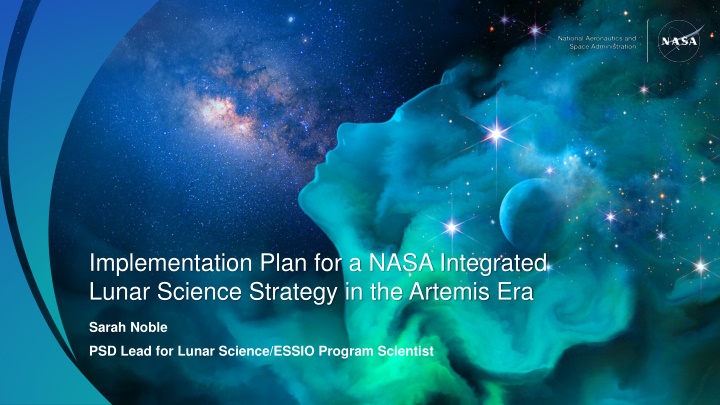

![get⚡[PDF]❤ Building Habitats on the Moon: Engineering Approaches to Lunar Settle](/thumb/21624/get-pdf-building-habitats-on-the-moon-engineering-approaches-to-lunar-settle.jpg)
